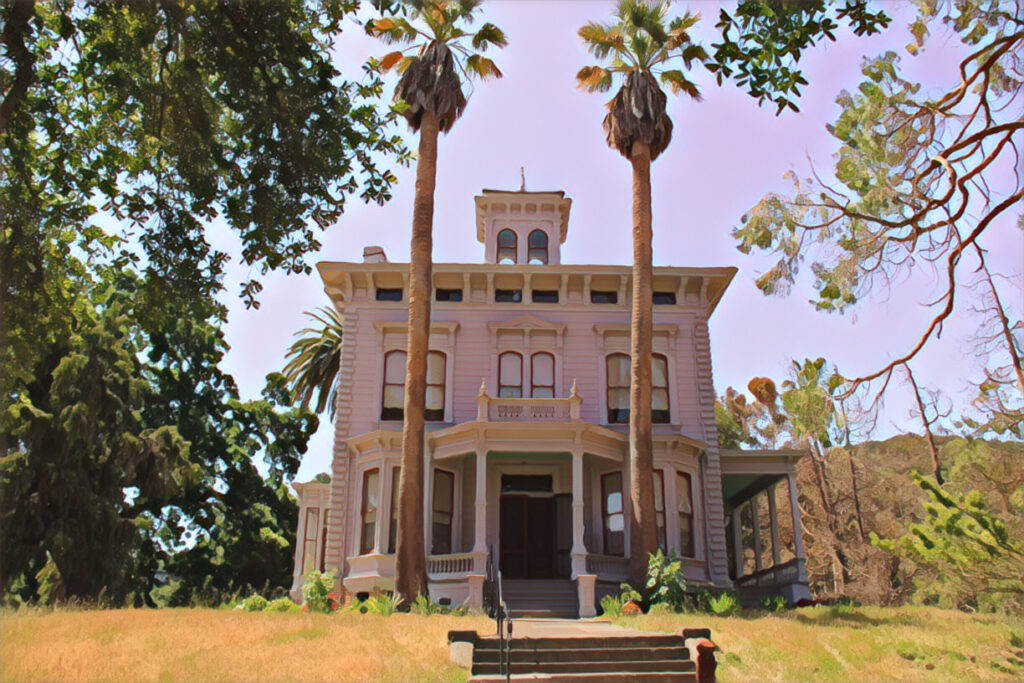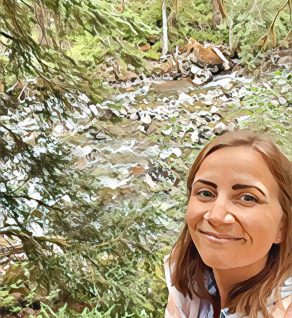This post contains affiliate links
A visit to the John Muir National Historic Site is absolutely worth it if you’re in the Martinez area–roughly 35 miles northwest of San Francisco or just want to pay homage to the father of our National Parks System. Muir authored dozens of books, essays, magazine articles and more during his lifetime. As an added bonus, the John Muir National Historic Site is always free to visit!
For more on John Muir visit the National Park he was integral in preserving–Yosemite National Park–and be sure to check out the Yosemite Conservation Heritage Center (a library and the park’s first visitor’s center!) while you’re there.
A SMALL HISTORY OF JOHN MUIR
Travel to any western National Park in the United States and it’s hard to avoid seeing the name John Muir. Of course, there are schools, streets, trails, local parks, and hospitals named after him as well. Considered to be the “Father of the National Parks,” John Muir was born in Scotland in 1838 and immigrated to America in 1849 as his family decided to flee the strict teachings and practices of the Church of Scotland.
The family settled in Wisconsin where Muir would attend the University of Wisconsin in Madison just 13 years after it was founded. He was 22 years old and was one of 77 students at the time. It was there that he first became curious and then fell in love with botany.
Muir spent time living in Indiana where he nearly lost an eye after being injured on the job while working at a wagon wheel factory. When he regained his sight, he obtained a new perspective on the world and shortly after decided to walk from Kentucky to Florida which he recounted in A Thousand-Mile Walk to the Gulf.

He battled malaria in Florida, recovered, and then sailed to Cuba, New York, and finally booked passage to California. Once in San Francisco, Muir took a one week trip to Yosemite for the first time. In 1869, he worked a season in the valley as a shepherd and wrote about his experiences during this time in his book My First Summer in the Sierra.
In the fall, he built a one room cabin near lower Yosemite falls in which he diverted a portion of Yosemite Creek to flow under his floorboards. He let ferns grow in through the floorboards. He lived in the cabin for nearly a year.
Muir met one of his idols in the park in 1871–Ralph Waldo Emereson–and accompanied him to Mariposa Grove. Though the elder Emerson was too frail to camp overnight, much to Muir’s disappointment. Muir continued to travel to Yosemite throughout the rest of his life though his intentions shifted from just reveling in nature to actively conserving it.

In 1903 when he was 65 years old he met President Theodore Roosevelt in the park. The men essentially ditched the secret service and went on a three day camping excursion. It was during this visit that Muir was able to convince the president to combine Yosemite Valley and Mariposa Grove under federal jurisdiction and expand the national parks system.
Over his lifetime, Muir would explore the Pacific Northwest and travel the globe. He wrote 12 books (some published posthumously), a collection of essays, and over 300 articles for outdoor magazines and others. He also co-founded the Sierra Club, a thriving nonprofit environmental organization.
The family life of John Muir seems to take the backburner to the rest of his adventures. But he was a husband and father to two girls. He was 40 years old when he went back to the Oakland area feeling pressure to “get back into society.” Soon, he was introduced to Louisa Strentzel who was the daughter of a distinguished physician and horticulturist who lived on a 2600 acre fruit orchard in the east bay town of Martinez.
The pair married in 1880 after Muir returned from a trip to Alaska and subsequently had two daughters, Wanda and Hellen. The family moved into a small cabin on the property (though that is long gone) and Muir spent a decade managing the fruit orchard for his father-in-law.

When Dr. John Strentzel died in 1890, his widow invited her daughter’s family to leave their cabin and come live in the big house on the hill. The 10,000 square foot Italianate Victorian home has 12 foot ceilings and a full attic and basement–plenty of room for five people.
John Muir lived in the house for the last 24 years of his life. While he maintained a strong marriage and was devoted to his daughters, Muir would often leave the family for months at a time to explore the West. He’d write about his experiences and encourage others to preserve the natural wildness of these places.
VISITING THE JOHN MUIR NATIONAL HISTORIC SITE
One thing I’ll say after having visited the John Muir National Historic Site is that while the property and home have been well preserved, time hasn’t stopped development from happening everywhere around it. I wonder how nature-loving Muir would feel about a gas station, bank, and busy street surrounding his land?
You’re offered a very small parking lot (maybe enough for ten vehicles) when you arrive at the John Muir National Historic Site. It was full when I visited so I parked across the street in a residential area for free and it was not a problem finding parking at all. Upon entering the property, you’ll go through the Visitor’s Center first.

There are Park Rangers here to help guide you and answer questions as well as a small selection of gifts and books for sale. There is a short informational film that introduces you to John Muir and the site.
The number one thing you’ll want to do at the is tour his house. It sits on nine historic acres that emcompasses the site. From the Visitor’s Center it’s a short walk up a hill (if you need assistance, staff can provide a ride).

The house is self-guided so you’ll have the ability to wander around as you please and there are volunteers on hand to answer questions or point out interesting details. The first floor consists of two parlors, dining room with an adjacent sunroom/conservatory, library, and a kitchen.
A few interesting things to note on this floor: The redwood paneled library was used by Dr. Strentzel but John Muir preferred a smaller and brighter bedroom-turned-office on the second floor. The mission style fireplace in the family parlor was built by Muir after the 1906 earthquake destroyed the original Italian marble one in its place.

Above the entryway to the house there is a window screen that has a crack running through the glass. While this occurred well after Muir’s death, the crack was caused by the 1944 blast at Port Chicago during WWII–just seven miles from the home.
The second floor offers an assortment of bedrooms including a restored version of Muir’s study. The attic and cupola are also available to walk through. Standing in the cupola is the best way to imagine what Muir’s view would have been like when he lived in the home.
After you’ve toured the home, spend time walking the property. I noted olive, pomegranate, apricot, quince, and fig trees which are representative of what grew here in Muir’s time as well.

On the western edge of the orchard sits the historic Martinez Adobe. This brick adobe home was built in 1849 by Don Vincente Martinez who was the son of the commandante of the Presidio of San Francisco. It changed ownership through the years and was finally purchased by Strentzel in 1874.
While Muir never lived here his daughter, Wanda, did with her husband and children. Muir would visit often. As of this writing it is closed due to structural damages.
TIP: If you’ve packed a picnic lunch there are a handful of tables under nice shade trees to enjoy lunch here.
The John Muir National Historic Site is located at 4202 Alhambra Avenue, Martinez, CA 94553. It’s open daily from 10am-5pm except Thanksgiving, Christmas, and New Year’s Day. Admission is free.
HIKE MOUNT WANDA
A quarter of a mile south from the visitor’s center at the John Muir National Historic Site is Mount Wanda, named after his daughter. This isn’t really a mountain but a handful of rolling hills and oak trees that offers a perfect place to hike.
Mount Wanda comprises 326 acres where Muir would hike with his daughters through old oaks and grasslands. The family never grew fruit here. A small parking lot is available where Alhambra Avenue meets Franklin Canyon Road (this is also where a trailhead is). Come prepared with water. There are no toilets, water, or other facilities available on Mount Wanda. Pets are permitted on a leash.
Mount Wanda is open daily from sunrise to sunset.
VISIT JOHN MUIR’S GRAVESITE
John Muir and his family are buried not far from the John Muir National Historic Site but it’s a bit of an adventure to find their graves. First, you need to get a gate code from the ranger at the visitor’s center. Don’t forget to do this before leaving the historic site!

From the visitor’s center you will drive south on Alhambra Avenue about three quarters of a mile and turn right onto Alhambra Valley Road. There is a small John Muir Memorial Park here that is worth a photo op. There’s also a tiny gravel parking lot here that is the official parking for the gravesites deemed by the NPS.
I found the lot to be full when I arrived so I kept driving and turned left on the next residential street called Gilbert Court. Parking here was no problem but keep in mind it’s a quiet residential street.
From here you have to walk south on Alhambra Valley Road. It’s a fairly busy road and in some parts you lose a sidewalk. I felt completely safe by myself but it’s not something you’d want to do with small children. You’ll pass by an elementary school. Turn left on Sheridan Lane and walk until it curves to the right. At this point, you are in the middle of a very quiet residential neighborhood and it feels quite awkward as there are no sidewalks.

After Sheridan Lane curves to the right you’ll see an opening and a gate. Punch in the gate code and the gate will open for you. Then’s it’s a very short walk to John Muir’s gravesite.
The gravesite is open Monday-Friday from 10:30am-4:30pm. Ranger led tours may be available on the weekends and require a reservation.
That’s everything you need to know to discover the John Muir National Historic Site. Have you visited before? Let is know in the comments!







